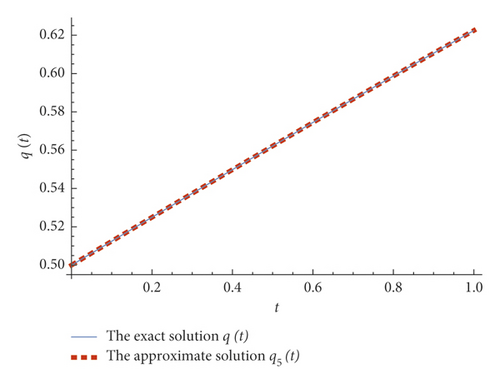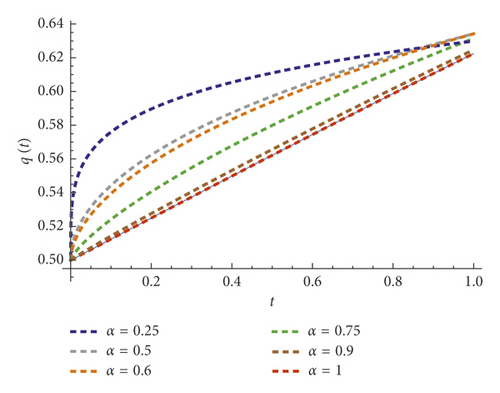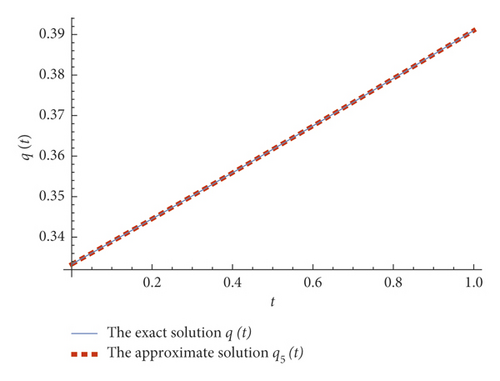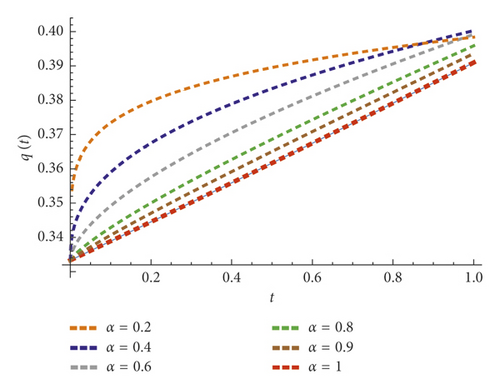Advanced Analytical Treatment of Fractional Logistic Equations Based on Residual Error Functions
Abstract
In this article, an analytical reliable treatment based on the concept of residual error functions is employed to address the series solution of the differential logistic system in the fractional sense. The proposed technique is a combination of the generalized Taylor series and minimizing the residual error function. The solution methodology depends on the generation of a fractional expansion in an effective convergence formula, as well as on the optimization of truncated errors, , through the use of repeated Caputo derivatives without any restrictive assumptions of system nature. To achieve this, some logistic patterns are tested to demonstrate the reliability and applicability of the suggested approach. Numerical comparison depicts that the proposed technique has high accuracy and less computational effect and is more efficient.
1. Introduction
Scientists were interested in studying differential equations in the fractional sense as flexible mathematical frameworks for modeling, measuring, and describing genetic structures, memory and material transfer, and multiple processes that have recently become an increasingly stimulating area of engineering and science applications, including but not limited to viscosity, fluid mechanics, optimal control, oscillation, signal processing, anomalous diffusion, electromagnetic, and fractal geometry [1–6]. When comparing with the integer order issues, the memory and hereditary properties of several substances are well and fully described by noninteger order issues. Anyhow, numerous attempts to provide numerical solutions to such equations exist in the literature, often due to the difficulty in finding analytical solutions accurately. Therefore, different numerical and approximation methods were introduced to handle those fractional systems [7–10].
In this research work, a reliable numerical treatment, the fractional residual power series method (FRPSM), is suggested for solving a sort of fractional logistic system. The FRPSM is an easy and reliable tool to obtain the values of unknown coefficients of desired fractional series solution for different types of linear and nonlinear FDEs without discretization, perturbation, and linearization by solving sequence of algebraic system [16–23]. The FRPS technique is primarily applied using the residual error concept and the repetition of Caputo derivatives to obtain the appropriate series solution by choosing a fit initial data, whereas the gained series solution and all fractional derivatives are valid for all mesh points of the domain of interest. To view the characteristics and advantages of numerical methods developed in dealing with various physical and engineering phenomena in the fractional sense, we refer to [24–31].
The rest of the current study is outlined in five sections. Characterization and primary results of the theory of fractional calculus are given as well as representation of fractional series solution is also provided in Section 2. In Section 3, the main procedures of the proposed algorithm are discussed to construct the required series solution. In Section 4, several applications are considered to confirm the performance and reliability of the present FRPSM. The conclusion is briefly presented finally.
2. Primary Mathematical Concepts
This section is devoted to concepts and results concerning the Caputo fractional derivatives and generalized power series representations. Throughout this research, the order α of fractional derivatives is a nonnegative real constant.
Definition 1. [2]. The Riemann–Liouville fractional integral operator with order α ≥ 0 is given by
Definition 2. [2]. The operator of fractional derivative with order α ≥ 0 for q(t) is given by
The operator satisfies the following properties:
- (i)
, c ∈ ℝ
- (ii)
, n − 1 < α < n, γ > n − 1, and is equal to zero otherwise
- (iii)
for A, B ∈ ℝ, that is, is linear operator
Moreover, for 0 ≤ τ < t, q ∈ Cn[a, b] , and n − 1 < α ≤ n, n ∈ ℕ, as well as for α ≥ 0, we have .
Remark 1. [19]. For an arbitrary function q(t), 0 ≤ τ < t, the Caputo fractional derivative can be computed by the following formula:
It is worth mentioning that the fractional calculus has a nonlocal property, so solving fractional differential equations is a challenge, especially for numerical calculations. This property indeed is the main reason why fractional calculus is more popular and good tool for modeling reality. However, Taylor expansion in the fractional sense does not give an approximation of the function at a point because of nonlocality. Anyhow, the local fractional Taylor formula has been successfully generalized and applied in science and engineering problems based on the theory of fractal geometry; for more details, we refer to [32–34].
Definition 3. [20]. The fractional power series “FPS” about t = t0 for n − 1 < α ≤ n is given by
Theorem 1. [20]. According to the FPS , there are the following possibilities:
- (1)
The series converges only for t = t0wheneverRis equal to zero
- (2)
The series converges∀t ≥ t0wheneverRis equal to infinity
- (3)
The series converges at t ∈ [t0, t0 + R) forR > 0and diverges fort > t0 + R
Lemma 1. Assume that , and 0 < α ≤ 1. Then,
Proof. From the properties of Caputo fractional operator, one can deduce that
On the other hand, for , we infer that
Theorem 2. [19]. Assuming that q(t) has the following power series expansion about t = t0:
If q(t) ∈ C[t0, t0 + R) and Diαq(t) ∈ C(t0, t0 + R), i = 0,1,2, …, then coefficient ai is given by where (i-times).
3. The FRPS Approach
Further, when the same routine is repeated as above up to the arbitrary order k, the coefficients an, n = 4,5,6, …, k, can be obtained.
Theorem 3. Assuming that q(t) satisfies the conditions of (11) with R > 0 such that . Then,
Proof. Clearly,
Using Lemma 1, it is obvious that
This, in turn, implies that
On the other hand, we get that
Hence, one can deduce the stated result.
Remark 2. If on [t0, t0 + R), then the upper bound of RN(ζ) can be obtained by
4. Illustrative Examples
In this section, numerical applications of the fractional logistic differential equations are presented and quantified at some mesh points. Numerical outcomes highlight the globality of the proposed algorithm in obtaining string solutions consistently and also show that the approximate values are highly acceptable in terms of stability and accuracy. In the calculation, all symbolic and digital calculations are performed using Mathematica software package.
Example 1. Consider the fractional logistic differential equation
The exact solution of IVP (31) and (32) at α = 1 is given by
According the FRPS algorithm, the FPS solution to (31) has the form
Now, define the residual error for equation (31) by
Following the FRPS algorithm to find out the coefficients an, n = 1,2,3, …, j, of equation (34). Let the first truncated PS approximation has the form
From equation (36) at j = 1, we have
For j = 2, the second truncated PS approximation has the form
Now, applying on both sides of equation (41) such that
Using the results of equation (16) at j = 2, , we have a2 = 0. So, the second approximation is
For j = 3, the third truncated PS approximation has the form
Now, applying on both sides of (46) such that
Using and then continuing in this process, one can get that
Consequently, few terms of RPS solution are
The numerical results of the 5th FRP solution are given in Table 1 with α = 1 in the interval (0, 1) with step size h = 0.1. Figure 1 shows a comparison between the behavior of the exact solution and the approximate solution at α = 1, while in Table 2, numerical comparison is given between the proposed method and the optimal homotopy asymptotic method (OHAM) [15] at α = 1. In Figure 2, the behavior of the 5th FPRS approximation is presented with different values of α, where α ∈ {1.0, 0.9, 0.75, 0.5, 0.25} and with step size of 0.2, whereas in Table 3, we review the numerical comparison between the FRPS solutions and the OHAM [15] when α = 1 with step size of 0.3. Anyhow, Table 4 shows the representation of the 6th approximate solution with different values of α such that α ∈ {1.0, 0.75, 0.5, 0.25}. From these results, it can be observed that the behavior of the approximate solutions for different values of α is in good agreement with each other that depends on the fractional order α.
| t | Exact solution | Approximations | Absolute error | Relative error |
|---|---|---|---|---|
| 0.1 | 0.5124973965 | 0.5124973965 | 0 | 0 |
| 0.2 | 0.5249791875 | 0.5249791875 | 0 | 0 |
| 0.3 | 0.5374298453 | 0.5374298457 | 3.59375 × 10−10 | 6.68692 × 10−10 |
| 0.4 | 0.5498339973 | 0.5498340000 | 2.68752 × 10−9 | 4.88787 × 10−9 |
| 0.5 | 0.5621765009 | 0.5621765137 | 1.27861 × 10−8 | 2.27438 × 10−8 |
| 0.6 | 0.5744425168 | 0.5744425625 | 4.56883 × 10−8 | 7.95351 × 10−8 |
| 0.7 | 0.5866175789 | 0.5866177129 | 1.33973 × 10−7 | 2.28382 × 10−7 |
| 0.8 | 0.5986876601 | 0.5986880000 | 3.39887 × 10−7 | 5.67721 × 10−7 |
| 0.9 | 0.6106392339 | 0.6106400059 | 7.71910 × 10−7 | 1.26410 × 10−6 |

| t | Exact | Approximations | Absolute error | ||
|---|---|---|---|---|---|
| FRPSM | OHAM | FRPSM | OHAM | ||
| 0.0 | 0.5 | 0.5 | 0.5 | 0.00 | 0.00 |
| 0.3 | 0.5374298453 | 0.5374298457 | 0.5374288935 | 3.59375 × 10−10 | 9.52 × 10−7 |
| 0.6 | 0.5744425168 | 0.5744425625 | 0.5744461429 | 4.56883 × 10−8 | 3.63 × 10−6 |
| 0.9 | 0.6106392339 | 0.6106400059 | 0.6106416979 | 7.71910 × 10−7 | 2.46 × 10−6 |

| t | α = 1 | α = 0.9 | α = 0.75 | α = 0.5 |
|---|---|---|---|---|
| 0.0 | 0.5 | 0.5 | 0.5 | 0.5 |
| 0.2 | 0.5249791875 | 0.5304889353505724 | 0.5405474790276749 | 0.5624203934410724 |
| 0.4 | 0.5498340000 | 0.5566921519428415 | 0.5678024178207643 | 0.5873774649503688 |
| 0.6 | 0.5744425625 | 0.5812250955770806 | 0.5912278649203895 | 0.6059542706735661 |
| 0.8 | 0.5986880000 | 0.6266870034872078 | 0.6122323913149167 | 0.6211659591174139 |
| 1.0 | 0.6224609375 | 0.6266870034872078 | 0.6314223950369852 | 0.6341997586473209 |
| αi | FPS approximate solution q6(t) |
|---|---|
| 1/4 | |
| 1/2 | |
| 3/4 | |
| 1 | q6(t) = (1/2) + (1/8)t + (1/384)t3 + (1/15360)t5 |
Example 2. Consider the fractional logistic differential equation
The exact solution of IVP (49) and (50) at α = 1 is given by
According to the FRPS algorithm, the FPS solution of (49) has the form
Now, the residual error of equation (49) can be defined by
In view of the FRPS algorithm, few terms an, n = 1,2,3,4, of equation (52) are given by
In Table 5, the numerical error of the 5th FRPS solution is presented for α = 1 on [0,1] with step size of 0.1. In Table 6, the numerical results of the 5th FRPS solution are given for different values of α on [0,1] with step size of 0.2. The exact and approximate solutions for α = 1, t ∈ [0,1] and n = 5 are shown in Figure 3, while the behaviors of FRPS solutions are plotted for different values of α in Figure 4. From these results, it can be observed that the behavior of the approximate solutions for different values of α is in good agreement with each other that depends on the fractional order α.
| t | Exact solution | Approximations | Absolute error | Relative error |
|---|---|---|---|---|
| 0.1 | 0.3389118421 | 0.3389118421 | 0 | 0 |
| 0.2 | 0.3445354618 | 0.3445354618 | 1.00 × 10−11 | 3.00 × 10−11 |
| 0.3 | 0.3502029635 | 0.3502029634 | 1.00 × 10−10 | 2.00 × 10−10 |
| 0.4 | 0.3559130712 | 0.3559130706 | 5.60 × 10−9 | 1.50 × 10−9 |
| 0.5 | 0.3616644631 | 0.3616644609 | 2.15 × 10−8 | 5.90 × 10−9 |
| 0.6 | 0.3674557720 | 0.3674557656 | 6.40 × 10−8 | 1.74 × 10−8 |
| 0.7 | 0.3732855868 | 0.3732855706 | 1.61 × 10−7 | 4.33 × 10−8 |
| 0.8 | 0.3791524531 | 0.3791524170 | 3.60 × 10−7 | 9.51 × 10−8 |
| 0.9 | 0.3850548747 | 0.3850548016 | 7.31 × 10−7 | 1.90 × 10−7 |
| t | α = 1 | α = 0.9 | α = 0.75 | α = 0.5 |
|---|---|---|---|---|
| 0.0 | 0.3333333333 | 0.33333333333 | 0.33333333333 | 0.33333333333 |
| 0.2 | 0.3445354618 | 0.34705266128 | 0.35171387863 | 0.36224905383 |
| 0.4 | 0.3559130706 | 0.35916526544 | 0.36457322181 | 0.37469934920 |
| 0.6 | 0.3674557656 | 0.37084329986 | 0.37604627351 | 0.38441631947 |
| 0.8 | 0.3791524170 | 0.38228876744 | 0.38673297588 | 0.39270737781 |
| 1.0 | 0.3909911774 | 0.39358561694 | 0.39688357406 | 0.40007972096 |


5. Conclusions
This study targets to implement the FRPS method for investigating the approximate solution of fractional logistic system subject to fit initial condition. The target has been accomplished successfully through extending the FRPS algorithm to handle such type of FDEs. The present method provides a solution in rapidly convergent FPS without linearization, or any limitations. Some numerical applications are performed to show the efficiency and reliability of the presented algorithm using Mathematica software package. The obtained results showed that the FRPSM is an easy, efficient, and systematic algorithm to provide analytic series solutions to various emerging systems of science.
Conflicts of Interest
The authors declare that they have no conflicts of interest.
Open Research
Data Availability
The data used to support the findings of this study are available from the corresponding author upon request.




